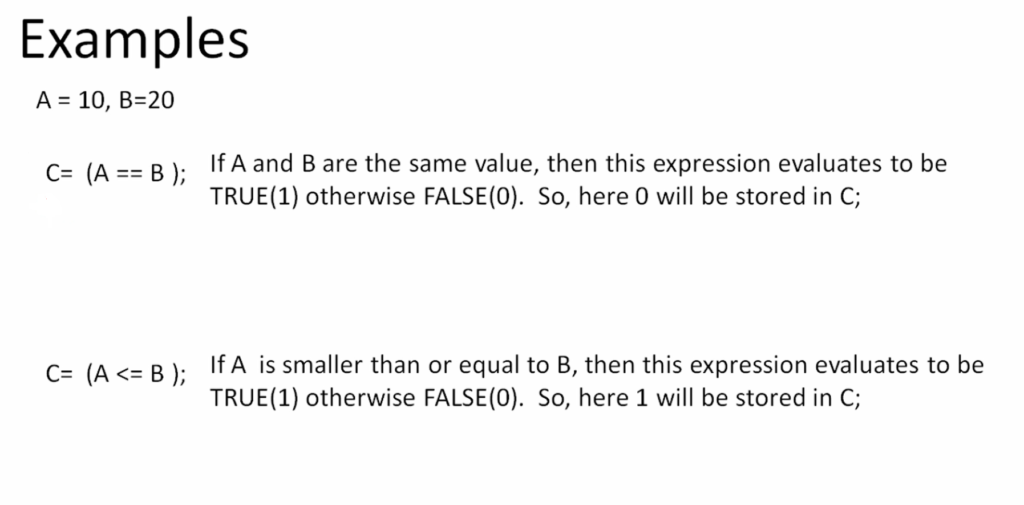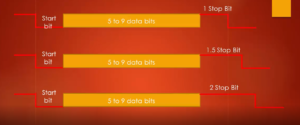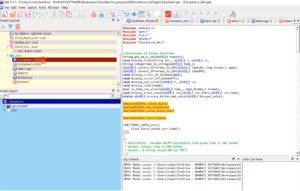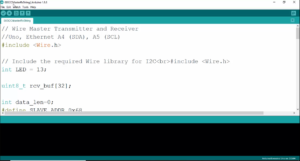Relational operators in ‘C’
Relational operators in ‘C’
- Relational operators do some kind of evaluation on the operands and then return value 1(for true) or 0(for false).
- Relational operators are binary operators because they require two operands to operate.
- The relational operators are evaluated left to right.
The available Relational operators in the ‘C’ programming language are shown in Figure 1. So use it for the evaluation.

Equal to (==):
First relational operator is ‘==’ (Equal to).
Syntax: expression1 == expression2
Please note the ‘==’(double equal to) sign here. Most of the beginners make mistakes by mentioning the single ‘=’ sign. So, the single ‘=’ sign is the assignment operator, not = (equal to) operator. You have to use double equal to(==) sign for equal to operator.
For example, you have two variables, a and b. And if you want to check whether a is equal to b, then you have to use the double equal to(==) operate. So, a == b returns 1 if a and b are the same. That’s very simple to understand.
Greater than (>):
Syntax: expression1 > expression2
>(greater than) is another relational operator for greater than evaluation.
a>b, this expression returns 1 if a is larger than b.
Less than (<):
< is for Less than.
Syntax: expression1 < expression2
The less than operator checks if expression1 is less than expression2. If expression1 is less, it returns true(1); otherwise, it returns false(0).
Greater than or equal to (>=):
Syntax: expression1 >= expression2
The greater than or equal to operator checks if expression1 is greater than or equal to expression2. If expression1 is greater or equal, it returns true; otherwise, it returns false.
a>=b returns 1, if a is larger than or equal to b
Less than or equal to (<=):
Syntax: expression1 <= expression2
The less than or equal to operator checks if expression1 is less than or equal to expression2. If expression1 is less or equal, it returns true; otherwise, it returns false.
Not equal to (!=):
Syntax: expression1 != expression2
Suppose if you do a!= b, this expression returns 1 if a is not equal to b. So, if a == b, then this expression will give you 0. That’s why relational operators are evaluation operators. So, they will either turn into 1 or 0.
‘True’ and ‘False’ in C
- In ‘C,’ Zero is interpreted as false and anything non-zero is interpreted as true.
In ‘C,’ 0 is false, and anything non-zero is true. So, -1 is true, -9 is true, so non-zero means true in ‘C’.
- The expressions using relational operators evaluate to a value of either TRUE(1) or FALSE(0).
- Relational expressions are often used within if and while statements.
Examples:
Let’s see some examples.

You have two variables, A and B. A=10 and B=20.
Let’s take a look at the C= (A==B) statement. This is a valid ‘C’ statement. Remember that ‘=‘ is the assignment operator, and ‘==‘ is equal to operator. Here, look into this expression A == B, which means you are checking whether A is really equal to B or not. If A and B are the same value, then this expression evaluates to be TRUE(1); otherwise, FALSE(0). Since A is not equal to B in reality, the A==B expression is evaluated to be FALSE(0). So, C = 0 in this case. 0 will be stored in C.
Here, take C=(A<=B) this expression. This expression will yield you 1 because A is less than B. So, C = 1 in this case.

Let’s look into this C=(A!= B) expression, which is true. A is not equal to B. So, C will be 1 in this case.
Take C= (A<B).In this expression, A is less than B. So, C=1.
Get the Full Course on Microcontroller Embedded C Programming Here.
FastBit Embedded Brain Academy Courses
Click here: https://fastbitlab.com/course1



